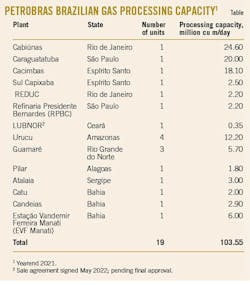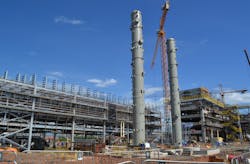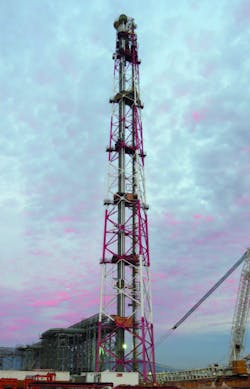Petrobras advances Route 3 presalt gas plant on revised timeline
Petróleo Brasileiro SA (Petrobras) has revised its timeline for commissioning of a new natural gas processing unit (UPGN) under construction at the Polo GasLub Itaboraí hub in Itaborai, Rio de Janeiro, Brazil, as part of the operator’s Route 3 integrated project to expand transportation and processing of associated gas from the country’s offshore Santos basin presalt (OGJ Online, July 25, 2016).
Most recently scheduled for startup by yearend 2022, startup of the Route 3 UPGN will be delayed by at least a year after the operator terminated its agreement with the project’s main contractor in late-September 2022 amid the latter’s inability to pay its workers.
In addition to examining the latest delay to the gas-plant portion of the Route 3 development plan, this article updates Petrobras’ progress to date on works to complete the integrated project that forms a core of the operator’s strategy to increase Brazil’s supply of domestic natural gas by 10% and reduce the need for imports (OGJ Online, Nov. 29, 2021).
Construction delay
In late-March 2018, Petrobras let a $600-million contract to a consortium of Shandong Kerui Petroleum Equipment Co. Ltd. (SPE Kerui) of China and Método Potencial Engenharia SA (Método), Sao Paulo, to provide engineering, procurement, and construction (EPC) on the Route 3 UPGN that will process 21 million-cu m/day of natural gas from presalt fields in Brazil’s Santos basin (OGJ Online, Mar. 28, 2018).
Work began immediately to meet the gas plant’s originally planned startup in second-half 2020. Prevention measures to stem the coronavirus outbreak in early 2020 resulted in Petrobras subsequently deferring commissioning of the Route 3 UPGN to 2022.
While post-pandemic construction activities at GasLub Itaboraí (formerly the Petrochemical Complex of Rio de Janeiro, or Comperj) resumed and appeared to be progressing smoothly, Método in January 2022 filed for court-supervised business reorganization, or judicial recovery—which is similar to bankruptcy protection under Brazilian law—citing insolvency based on escalating costs of supplies, equipment, and materials needed to complete the project. Shortly thereafter and through first-half 2022, reports emerged from regional labor union Sindicato dos Petroleiros do Rio de Janeiro (Sendipetro-RJ) of various problems at the Itaboraí worksite, including allegations of theft, violence, health hazards, mass layoffs, and other poor conditions for outsourced workers, including the SPE Kerui- Método consortium’s inability to pay them.
In mid-July 2022, Petrobras informed investors that—despite the operator’s fulfillment of all commitments under its contract with SPE Kerui-Método—the consortium unilaterally decided to demobilize its workforce assigned to Route 3 UPGN. As of July 11, work to complete the project halted, with only activities to preserve existing equipment and installations at the site ongoing.
Petrobras confirmed on Sept. 23, 2022, that it had terminated its contract with SPE Kerui-Método and was in the process of seeking a new contractor to conclude the remaining engineering and construction works required to complete the gas plant. Cancellation of the SPE Kerui-Método contract, however, has delayed startup of the Route 3 UPGN—now the final project of the broader GasLub Itaboraí hub left to be completed—to 2024.
Formally opened on Sept. 15, 2022, Petrobras’ tender seeking a replacement contractor to complete the remaining scope of work on the Route 3 UPGN is scheduled to close on Nov. 16, 2022. The winning bidder will be required to deliver civil construction, electromechanical assembly, interconnections, commissioning, pre-operational and start-up services, as well as assisted operation of lingering works for both gas processing units of the GasLub Itaboraí complex’s Route 3 gas plant, including supply of materials and equipment.
Route 3 project overview
Part of the Petrobras’ repositioning plan for its cancelled Comperj integrated refining project—renamed as GasLub Itaboraí in 2020—the Route 3 combined gas pipeline-UPGN project’s integration with the previously completed Route 1 and Route 2 pipeline projects aims to increase the operator’s presalt gas offloading and processing capacity to 44 million cu m/day from 23 million cu m/day (Fig. 1; OGJ Online, Dec. 23, 2019).
Alongside the new Route 3 UPGN—which will consist of two 10.5-million cu m/day processing trains—the Route 3 project includes a 355-km gas pipeline (307 km offshore, 48 km onshore) that will deliver about 18 million cu m/day of natural gas from the Santos basin presalt cluster to the UPGN at GasLub Itaboraí.
By providing an outlet for associated gas from the Santos basin presalt area, Petrobras said it expects completion of the Route 3 project also will enable increased production of crude oil from the presalt offshore fields.
Project progress
Before the halt to construction activities for the Route 3 UPGN, a series of major works on the new gas plant and associated pipeline system had already been completed.
In a series of Petrobras Informas regional updates issued between October 2019 and February 2022, the company confirmed concluding the following construction-related activities on the Route 3 UPGN and gas pipeline:
- Installation of the UPGN’s first six processing towers in February 2020, which was to be followed by installation of the plant’s second and final batch of seven processing towers in May 2020 (Fig. 2).
- Achieving 50% of the UPGN’s physical construction by yearend 2019, including laying of foundations, bases, drainage, and paving, in addition to advanced assembly of about 3,000 tonnes of piping and 2,000 tonnes of metallic structures and other unidentified electromechanical equipment.
- Installation by October 2019 of the UPGN’s 156-m high flare tower and associated equipment to disperse gases and heat produced during processing operations. The flare tower consists of two burners: one with a maximum relief flow of up to 1,400 tonnes/hr for burning hydrocarbon gases, and another equipped to burn acid gases at a rate of up to 240 tonnes/hr (Fig. 3).
- Assembly and installation of GasLub Itaboraí’s air-cooling system to prevent overheating of the UPGN’s equipment from heat generated by the site’s associated electrical system. (Fig. 4).
- Delivery of other major equipment by yearend 2019, including the onshore complex’s prefabricated electrical system.
The site’s water treatment plant, substations responsible for energy distribution—including electricity—an integrated control center, auxiliary utilities systems, and the flare system also were already operating, Petrobras said.
Petrobras—which completed installation of the deepwater sections of the Route 3 pipeline in 2019, and shallow-water and onshore sections in early 2022—began partial operation of the pipeline’s ultradeep and deep maritime sections in June 2022 with an undisclosed volume of pre-salt natural gas deliveries from the P-77 platform in Santos basin presalt layer’s Búzios field (Fig. 5). At the time, natural gas flows through the operable Route 3 portion of the line were directed via an interconnection to the Route 2 gas pipeline for delivery to the 24.6-million cu m/day Cabiúnas gas processing plant in Macaé, Rio de Janeiro.
Petrobras also is continuing to evaluate integration of some units at GasLub Itaboraí with its 239,000-b/d Duque de Caxias (REDUC) refinery in the Baixada Fluminense area of Brazil’s Rio de Janeiro state for production of basic lubricants and fuels from intermediate products delivered via pipeline from the refinery to the Itaboraí gas hub. The company is considering partnering with outside investors to build and operate a natural gas-based thermoelectric plant at Itaboraí.
Gas processing operations
As of yearend 2021, Petrobras operated a combined natural gas processing capacity in Brazil of 103.55 million cu m/day across 19 plants, one of which is at the operator’s soon-to-be-divested 10,400-b/d Lubrificantes e Derivados de Petróleo do Nordeste (LUBNOR) refinery in Fortaleza, Ceará, Brazil (OGJ Online, May 26, 2022). Scheduled to close by yearend, the LUBNOR sale remained pending at press time.
The accompanying table shows a list of Petrobras’ current gas processing plants and their capacities.

Robert Brelsford | Downstream Editor
Robert Brelsford joined Oil & Gas Journal in October 2013 as downstream technology editor after 8 years as a crude oil price and news reporter on spot crude transactions at the US Gulf Coast, West Coast, Canadian, and Latin American markets. He holds a BA (2000) in English from Rice University and an MS (2003) in education and social policy from Northwestern University.






